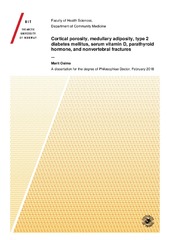| dc.contributor.advisor | Bjørnerem, Åshild | |
| dc.contributor.author | Osima, Marit | |
| dc.date.accessioned | 2018-04-16T09:59:26Z | |
| dc.date.available | 2018-04-16T09:59:26Z | |
| dc.date.issued | 2018-03-28 | |
| dc.description.abstract | Despite advances in therapies, assessment of fracture risk, and diagnosis of bone fragility, few women and men with high fracture risk receive treatment, even after they develop fracture. To be able to recognize and identify subjects who are at risk for fragility fracture, and to target treatment well, it is important to search for risk factors that are associated with, or ideally, predict fracture.
<br>
In case-control studies from Tromsø and Melbourne, we studied medullary adiposity, type 2 diabetes mellitus, PTH and vitamin D, and explored the role of cortical porosity in the associations between risk factors and nonvertebral fracture.
<br>
Fracture cases had higher distal tibial medullary adiposity and higher cortical porosity. Higher medullary adiposity and cortical porosity were associated with increased odds for nonvertebral fracture, independent of bone mineral density. Women with T2DM had lower cortical porosity than those without diabetes, higher glucose was associated with lower BTM and lower cortical porosity. Higher BMI was associated with lower BTM and thicker cortices. Women with fracture had lower serum 25(OH)D and higher PTH and BTM than controls, and they had increased femoral subtrochanteric cortical porosity, and reduced cortical thickness. Lower serum 25(OH)D was not associated with cortical parameters or BTM. Higher PTH was associated with increased BTM and higher cortical porosity of the inner transitional zone. Moreover, decreasing 25(OH)D and increasing PTH increased odds for fracture independent of cortical porosity and covariates.
<br>
Combining medullary adiposity and cortical porosity may improve identification of women at risk for fracture. Cortical porosity is lower in women with T2DM than in those without. PTH increases intracortical bone turnover, leading to trabecularization of the inner cortical bone. | en_US |
| dc.description.doctoraltype | ph.d. | en_US |
| dc.description.sponsorship | The North Norwegian Health Authorities (ID5645, ID9167, ID9168, ID 10295) | en_US |
| dc.description | The paper III of this thesis is available in Munin in submitted manuscript version at <a href=http://hdl.handle.net/10037/12525> http://hdl.handle.net/10037/12525 </a>. <br>
Paper III: Osima, M., Borgen, T. T., Lukic, M., Grimnes, G., Joakimsen, R. M., Eriksen, E. F. & Bjørnerem, Å. (2018). Serum parathyroid hormone is associated with increased cortical porosity of the inner transitional zone at the proximal femur in postmenopausal women: The Tromsø Study. Published version available in <a href= https://doi.org/10.1007/s00198-017-4298-3> Osteoporos Int 2018, 29: 421. </a> | en_US |
| dc.identifier.uri | https://hdl.handle.net/10037/12524 | |
| dc.language.iso | eng | en_US |
| dc.publisher | UiT The Arctic University of Norway | en_US |
| dc.publisher | UiT Norges arktiske universitet | en_US |
| dc.relation.ispartofseries | ISM skriftserie; 189 | |
| dc.rights.accessRights | openAccess | en_US |
| dc.rights.holder | Copyright 2018 The Author(s) | |
| dc.rights.uri | https://creativecommons.org/licenses/by-nc-sa/3.0 | en_US |
| dc.rights | Attribution-NonCommercial-ShareAlike 3.0 Unported (CC BY-NC-SA 3.0) | en_US |
| dc.subject | VDP::Medisinske Fag: 700::Klinisk medisinske fag: 750::Endokrinologi: 774 | en_US |
| dc.subject | VDP::Medical disciplines: 700::Clinical medical disciplines: 750::Endocrinology: 774 | en_US |
| dc.subject | The Tromsø Study | |
| dc.subject | Tromsøundersøkelsen | |
| dc.title | Cortical porosity, medullary adiposity, type 2 diabetes mellitus, serum vitamin D, parathyroid hormone, and nonvertebral fractures | en_US |
| dc.type | Doctoral thesis | en_US |
| dc.type | Doktorgradsavhandling | en_US |


 English
English norsk
norsk


